Reconstructing Satellite-Based Monthly Precipitation over Northeast China Using Machine Learning Algorithms
Abstract
:1. Introduction
2. Study Area and Data Resources
2.1. Study Area
2.2. Data Resources
3. Methods
3.1. Precipitation Reconstruction Algorithm
- (1)
- In regions covered with snow, water bodies, and desert, the NDVI values are usually constant under 0.0. To eliminate the influence of snow and water bodies, the threshold NDVI < 0.0 was used to distinguish and remove snow, and water body pixels from original monthly NDVI images.
- (2)
- The LSTDN was calculated by subtracting LSTnight from LSTday; NDVI1km, DEM1km, LSTday-1km, LSTnight-1km, LSTDN-1km were resampled to 25 km resolution using an average method. The geographical coordinates of the center of each 25 × 25 km grid were extracted.
- (3)
- The relationship between the resampled independent variables and TRMM 3B43 V7 precipitation data were established using machine learning algorithms. In this study, we tested two machine learning algorithms for simulating the monthly precipitation, support vector machine (SVM) and random forests (RF).
- (4)
- The reconstruction of monthly precipitation in the study area was conducted on two scales. First, the resampled independent variables (NDVI, DEM, LSTday, LSTnight and LSTDN ) with 25 km spatial resolution were input into the established model. Reconstructed results of 25 km resolution were achieved. Second, the 1 km spatial resolution precipitation can be simulated by applying the established model to the variables with original 1 km spatial resolution.
3.2. Support Vector Machine (SVM)
3.3. Random Forests (RF)
- (1)
- The ntree (number of trees) samples sets are randomly drawn from the original training sample set with replacement. Each sample set is a bootstrap sample, and the elements that are not included in the bootstrap are termed “out-of-bag data” (OOB) for that bootstrap sample.
- (2)
- For each bootstrap sample, an un-pruned regression tree is grown with the modification that a random subset of the variables, from which the best variables are split, is selected at each node.
- (3)
- Predictions for new samples can be made by averaging the predictions from all the individual regression trees:where N is the number of trees, is the prediction from each individual regression tree.
4. Results and Analysis
4.1. Performance of Regression Algortihms
4.2. Reconstruction Results
4.3. Validation and Error Analysis
5. Discussion
5.1. Scale Sensitivity of the Model
5.2. Influence Factors of the Reconstructing Model
6. Conclusions
Acknowledgments
Author Contributions
Conflicts of Interest
References
- Sapiano, M.R.P.; Arkin, P.A. An intercomparison and validation of high-resolution satellite precipitation estimates with 3-hourly gauge data. J. Hydrometeorol. 2009, 10, 149–166. [Google Scholar] [CrossRef]
- Taylor, C.M.; de Jeu, R.A.M.; Guichard, F.; Harris, P.P.; Dorigo, W.A. Afternoon rain more likely over drier soils. Nature 2012, 489, 423–426. [Google Scholar] [CrossRef] [PubMed] [Green Version]
- Schwaller, M.R.; Morris, K.R. A ground validation network for the global precipitation measurement mission. J. Atmos. Ocean. Technol. 2011, 28, 301–319. [Google Scholar] [CrossRef]
- Schneider, U.; Becker, A.; Finger, P.; Meyer-Christoffer, A.; Ziese, M.; Rudolf, B. Gpcc’s new land surface precipitation climatology based on quality-controlled in situ data and its role in quantifying the global water cycle. Theor. Appl. Climatol. 2014, 115, 15–40. [Google Scholar] [CrossRef]
- Munoz, E.A.; Di Paola, F.; Lanfri, M.; Arteaga, F.J. Observing the troposphere through the advanced technology microwave sensor (atms) to retrieve rain rate. IEEE Lat. Am. Trans. 2016, 14, 586–594. [Google Scholar] [CrossRef]
- Sanò, P.; Panegrossi, G.; Casella, D.; Di Paola, F.; Milani, L.; Mugnai, A.; Petracca, M.; Dietrich, S. The passive microwave neural network precipitation retrieval (pnpr) algorithm for amsu/mhs observations: Description and application to european case studies. Atmos. Meas. Tech. 2015, 8, 837–857. [Google Scholar] [CrossRef]
- Munoz, E.A.; Paola, F.D.; Lanfri, M. Advances on rain rate retrieval from satellite platforms using artificial neural networks. IEEE Lat. Am. Trans. 2015, 13, 3179–3186. [Google Scholar] [CrossRef]
- Di Paola, F.; Ricciardelli, E.; Cimini, D.; Romano, F.; Viggiano, M.; Cuomo, V. Analysis of catania flash flood case study by using combined microwave and infrared technique. J. Hydrometeorol. 2014, 15, 1989–1998. [Google Scholar] [CrossRef]
- Cimini, D.; Romano, F.; Ricciardelli, E.; Di Paola, F.; Viggiano, M.; Marzano, F.S.; Colaiuda, V.; Picciotti, E.; Vulpiani, G.; Cuomo, V. Validation of satellite opemw precipitation product with ground-based weather radar and rain gauge networks. Atmos. Meas. Tech. 2013, 6, 3181–3196. [Google Scholar] [CrossRef]
- Di Paola, F.; Casella, D.; Dietrich, S.; Mugnai, A.; Ricciardelli, E.; Romano, F.; Sanò, P. Combined mw-ir precipitation evolving technique (pet) of convective rain fields. Nat. Hazards Earth Syst. Sci. 2012, 12, 3557–3570. [Google Scholar] [CrossRef] [Green Version]
- Casella, D.; Dietrich, S.; Di Paola, F.; Formenton, M.; Mugnai, A.; Porcù, F.; Sanò, P. Pm-gcd—A combined ir–mw satellite technique for frequent retrieval of heavy precipitation. Nat. Hazards Earth Syst. Sci. 2012, 12, 231–240. [Google Scholar] [CrossRef] [Green Version]
- Huffman, G.J.; Adler, R.F.; Arkin, P.; Chang, A.; Ferraro, R.; Gruber, A.; Janowiak, J.; McNab, A.; Rudolf, B.; Schneider, U. The global precipitation climatology project (gpcp) combined precipitation dataset. Bull. Am. Meteorol. Soc. 1997, 78, 5–20. [Google Scholar] [CrossRef]
- Duan, Z.; Bastiaanssen, W.G.M. First results from version 7 trmm 3b43 precipitation product in combination with a new downscaling–calibration procedure. Remote Sens. Environ. 2013, 131, 1–13. [Google Scholar] [CrossRef]
- Huffman, G.J.; Adler, R.F.; Curtis, S.; Bolvin, D.T.; Nelkin, E.J. Global rainfall analyses at monthly and 3-h time scales. In Measuring Precipitation from Space: Eurainsat and the Future; Levizzani, V., Bauer, P., Turk, F.J., Eds.; Springer: Dordrecht, The Netherlands, 2007; pp. 291–305. [Google Scholar]
- Munchak, S.J.; Skofronick-Jackson, G. Evaluation of precipitation detection over various surfaces from passive microwave imagers and sounders. Atmos. Res. 2013, 131, 81–94. [Google Scholar] [CrossRef]
- Kubota, T.; Shige, S.; Hashizume, H.; Aonashi, K.; Takahashi, N.; Seto, S.; Hirose, M.; Takayabu, Y.N.; Ushio, T.; Nakagawa, K.; et al. Global precipitation map using satellite-borne microwave radiometers by the gsmap project: Production and validation. IEEE Trans. Geosci. Remote Sens. 2007, 45, 2259–2275. [Google Scholar] [CrossRef]
- Joyce, R.J.; Janowiak, J.E.; Arkin, P.A.; Xie, P. Cmorph: A method that produces global precipitation estimates from passive microwave and infrared data at high spatial and temporal resolution. J. Hydrometeorol. 2004, 5, 287–296. [Google Scholar] [CrossRef]
- Bennartz, R.; Schroeder, M. Convective activity over africa and the tropical atlantic inferred from 20 years of geostationary meteosat infrared observations. J. Clim. 2012, 25, 156–169. [Google Scholar] [CrossRef]
- Huffman, G.J.; Bolvin, D.T.; Nelkin, E.J.; Wolff, D.B.; Adler, R.F.; Gu, G.; Hong, Y.; Bowman, K.P.; Stocker, E.F. The trmm multisatellite precipitation analysis (tmpa): Quasi-global, multiyear, combined-sensor precipitation estimates at fine scales. J. Hydrometeorol. 2007, 8, 38–55. [Google Scholar] [CrossRef]
- Asadullah, A.; McIntyre, N.; Kigobe, M.A.X. Evaluation of five satellite products for estimation of rainfall over uganda/evaluation de cinq produits satellitaires pour l’estimation des précipitations en ouganda. Hydrol. Sci. J. 2008, 53, 1137–1150. [Google Scholar] [CrossRef]
- Iguchi, T.; Kozu, T.; Meneghini, R.; Awaka, J.; Okamoto, K.I. Rain-profiling algorithm for the trmm precipitation radar. J. Appl. Meteorl. 2000, 39, 2038–2052. [Google Scholar] [CrossRef]
- Cui, Y.; Long, D.; Hong, Y.; Zeng, C.; Zhou, J.; Han, Z.; Liu, R.; Wan, W. Validation and reconstruction of fy-3b/mwri soil moisture using an artificial neural network based on reconstructed modis optical products over the tibetan plateau. J. Hydrol. 2016, 543, 242–254. [Google Scholar] [CrossRef]
- Coulibaly, P.; Evora, N.D. Comparison of neural network methods for infilling missing daily weather records. J. Hydrol. 2007, 341, 27–41. [Google Scholar] [CrossRef]
- Long, D.; Shen, Y.; Sun, A.; Hong, Y.; Longuevergne, L.; Yang, Y.; Li, B.; Chen, L. Drought and flood monitoring for a large karst plateau in southwest china using extended grace data. Remote Sens. Environ. 2014, 155, 145–160. [Google Scholar] [CrossRef]
- Zhang, X.; Friedl, M.A.; Schaaf, C.B.; Strahler, A.H.; Liu, Z. Monitoring the response of vegetation phenology to precipitation in africa by coupling modis and trmm instruments. J. Geophys. Res.: Atmos. 2005, 110. [Google Scholar] [CrossRef]
- Wang, J.; Price, K.P.; Rich, P.M. Spatial patterns of ndvi in response to precipitation and temperature in the central great plains. Int. J. Remote Sens. 2001, 22, 3827–3844. [Google Scholar] [CrossRef]
- Vicente-Serrano, S.M.; Gouveia, C.; Camarero, J.J.; Beguería, S.; Trigo, R.; López-Moreno, J.I.; Azorín-Molina, C.; Pasho, E.; Lorenzo-Lacruz, J.; Revuelto, J.; et al. Response of vegetation to drought time-scales across global land biomes. Proc. Natl. Acad. Sci. USA 2013, 110, 52–57. [Google Scholar] [CrossRef] [PubMed] [Green Version]
- Zhong, L.; Ma, Y.; Salama, M.S.; Su, Z. Assessment of vegetation dynamics and their response to variations in precipitation and temperature in the tibetan plateau. Clim. Chang. 2010, 103, 519–535. [Google Scholar] [CrossRef]
- Spracklen, D.V.; Arnold, S.R.; Taylor, C.M. Observations of increased tropical rainfall preceded by air passage over forests. Nature 2012, 489, 282–285. [Google Scholar] [CrossRef] [PubMed]
- Lemone, M.A.; Grossman, R.L.; Chen, F.; Ikeda, K.; Yates, D. Choosing the averaging interval for comparison of observed and modeled fluxes along aircraft transects over a heterogeneous surface. J. Hydrometeorol. 2003, 4, 179–195. [Google Scholar] [CrossRef]
- Trenberth, K.E.; Shea, D.J. Relationships between precipitation and surface temperature. Geophys. Res. Lett. 2005, 32. [Google Scholar] [CrossRef]
- De Kauwe, M.G.; Taylor, C.M.; Harris, P.P.; Weedon, G.P.; Ellis, R.J. Quantifying land surface temperature variability for two sahelian mesoscale regions during the wet season. J. Hydrometeorol. 2013, 14, 1605–1619. [Google Scholar] [CrossRef]
- Wallace, J.S.; Holwill, C.J. Soil evaporation from tiger-bush in south-west niger. J. Hydrol. 1997, 188–189, 426–442. [Google Scholar] [CrossRef]
- Kogan, F.N. Application of vegetation index and brightness temperature for drought detection. Adv. Space Res. 1995, 15, 91–100. [Google Scholar] [CrossRef]
- Liu, W.T.; Kogan, F.N. Monitoring regional drought using the vegetation condition index. Int. J. Remote Sens. 1996, 17, 2761–2782. [Google Scholar] [CrossRef]
- Guan, H.; Wilson, J.L.; Xie, H. A cluster-optimizing regression-based approach for precipitation spatial downscaling in mountainous terrain. J. Hydrol. 2009, 375, 578–588. [Google Scholar] [CrossRef]
- Yin, Z.-Y.; Zhang, X.; Liu, X.; Colella, M.; Chen, X. An assessment of the biases of satellite rainfall estimates over the tibetan plateau and correction methods based on topographic analysis. J. Hydrometeorol. 2008, 9, 301–326. [Google Scholar] [CrossRef]
- Sokol, Z.; Bližňák, V. Areal distribution and precipitation–altitude relationship of heavy short-term precipitation in the czech republic in the warm part of the year. Atmos. Res. 2009, 94, 652–662. [Google Scholar] [CrossRef]
- Xu, X.; Lu, C.; Shi, X.; Ding, Y. Large-scale topography of china: A factor for the seasonal progression of the meiyu rainband? J. Geophys. Res. 2010, 115. [Google Scholar] [CrossRef]
- Yang, F.; Lau, K.M. Trend and variability of china precipitation in spring and summer: Linkage to sea-surface temperatures. Int. J. Climatol. 2004, 24, 1625–1644. [Google Scholar] [CrossRef]
- Zhai, P.; Zhang, X.; Wan, H.; Pan, X. Trends in total precipitation and frequency of daily precipitation extremes over china. J. Clim. 2005, 18, 1096–1108. [Google Scholar] [CrossRef]
- Jarvis, A.; Reuter, H.I.; Nelson, A.; Guevara, E. Hole-Filled Srtm for the Globe Version 4. Available online: cgiar-csi srtm 90m database (accessed on 31 January 2016).
- Ahmad, S.; Kalra, A.; Stephen, H. Estimating soil moisture using remote sensing data: A machine learning approach. Adv. Water Resour. 2010, 33, 69–80. [Google Scholar] [CrossRef]
- Weng, Q. Remote sensing of impervious surfaces in the urban areas: Requirements, methods, and trends. Remote Sens. Environ. 2012, 117, 34–49. [Google Scholar] [CrossRef]
- Mountrakis, G.; Im, J.; Ogole, C. Support vector machines in remote sensing: A review. ISPRS J. Photogramm. Remote Sens. 2011, 66, 247–259. [Google Scholar] [CrossRef]
- Vapnik, V. The Nature of Statistical Learning Theory; Springer: New York, NY, USA, 1995. [Google Scholar]
- Vapnik, V. Statistical Learning Theory; Wiley: New York, NY, USA, 1998. [Google Scholar]
- Kalra, A.; Ahmad, S. Using Oceanic-Atmospheric Oscillations for Long Lead Time Streamflow Forecasting; American Geophysical Union: Washington, DC, USA, 2009; pp. 450–455. [Google Scholar]
- Gislason, P.O.; Benediktsson, J.A.; Sveinsson, J.R. Random forests for land cover classification. Pattern Recognit. Lett. 2006, 27, 294–300. [Google Scholar] [CrossRef]
- Breiman, L. Random forests. Mach. Learn. 2001, 45, 5–32. [Google Scholar] [CrossRef]
- Breiman, L.; Friedman, J.H.; Olshen, R.A.; Stone, C.J. Classification and Regression Trees; Chapman and Hall/CRC: Boca Raton, FL, USA, 1984. [Google Scholar]
- Pedregosa, F.; Varoquaux, G.; Gramfort, A.; Michel, V.; Thirion, B.; Grisel, O.; Blondel, M.; Prettenhofer, P.; Weiss, R.; Dubourg, V.; et al. Scikit-learn: Machine learning in python. J. Mach. Learn. Res. 2011, 12, 2825–2830. [Google Scholar]
- Li, C.; Wang, J.; Wang, L.; Hu, L.; Gong, P. Comparison of classification algorithms and training sample sizes in urban land classification with landsat thematic mapper imagery. Remote Sens. 2014, 6, 964–983. [Google Scholar] [CrossRef]
- Rokach, L.; Maimon, O. Data Mining with Decision Trees: Theory and Applications; World Scientific Pub Co. Inc.: 5 Toh Tuck Link, Singapore, 2008. [Google Scholar]
- Altman, N.S. An introduction to kernel and nearest-neighbor nonparametric regression. Am. Stat. 1992, 46, 175–185. [Google Scholar] [CrossRef]
- Harrington, P. Machine Learning in Action; Manning Publications: Hempstead, NY, USA, 2012. [Google Scholar]
- Hand, D.J.; Mannila, H.; Smyth, P. Principles of Data Mining; The MIT Press: Cambridge, MA, USA; London, UK, 2001; p. 546. [Google Scholar]
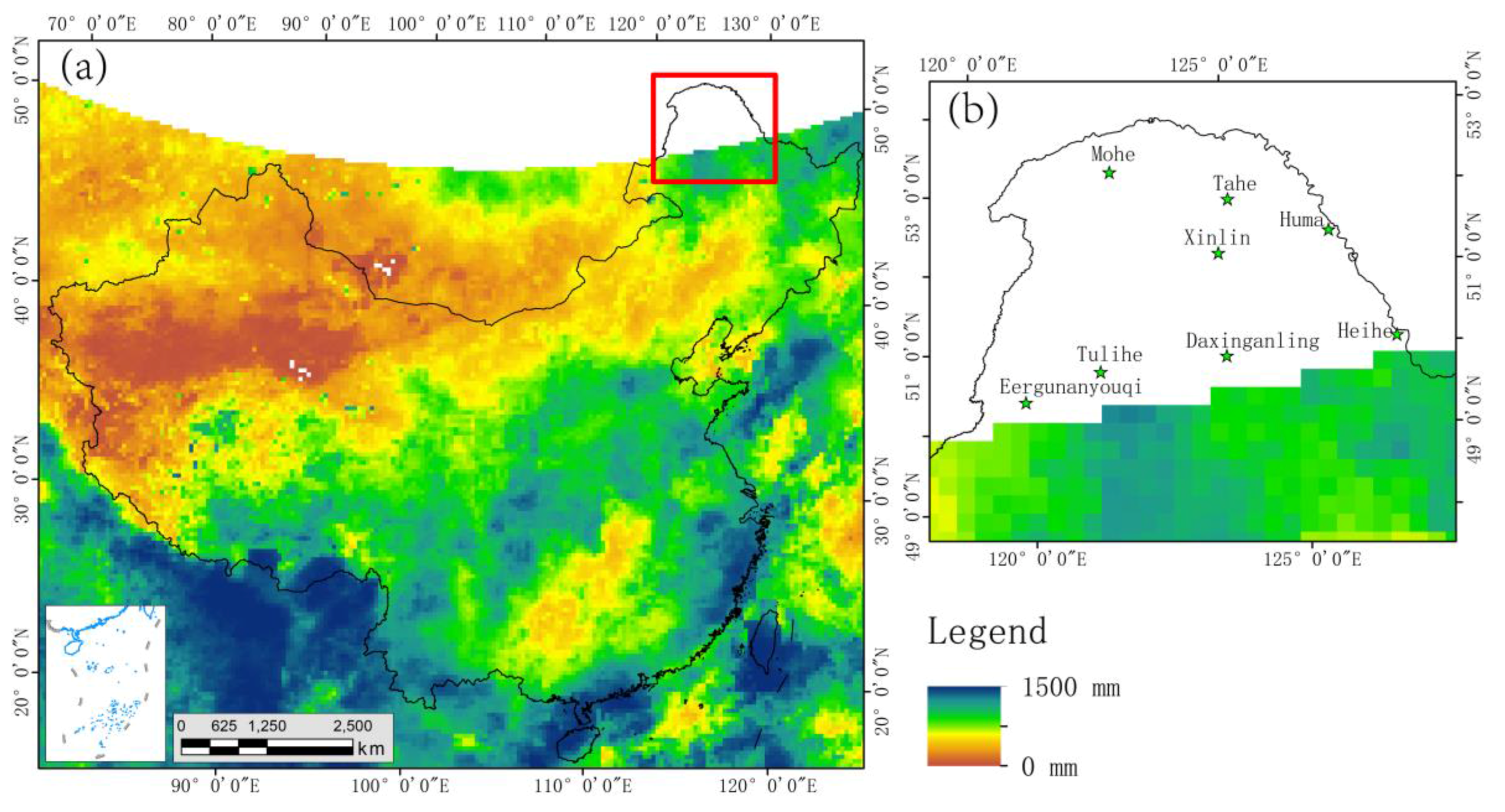


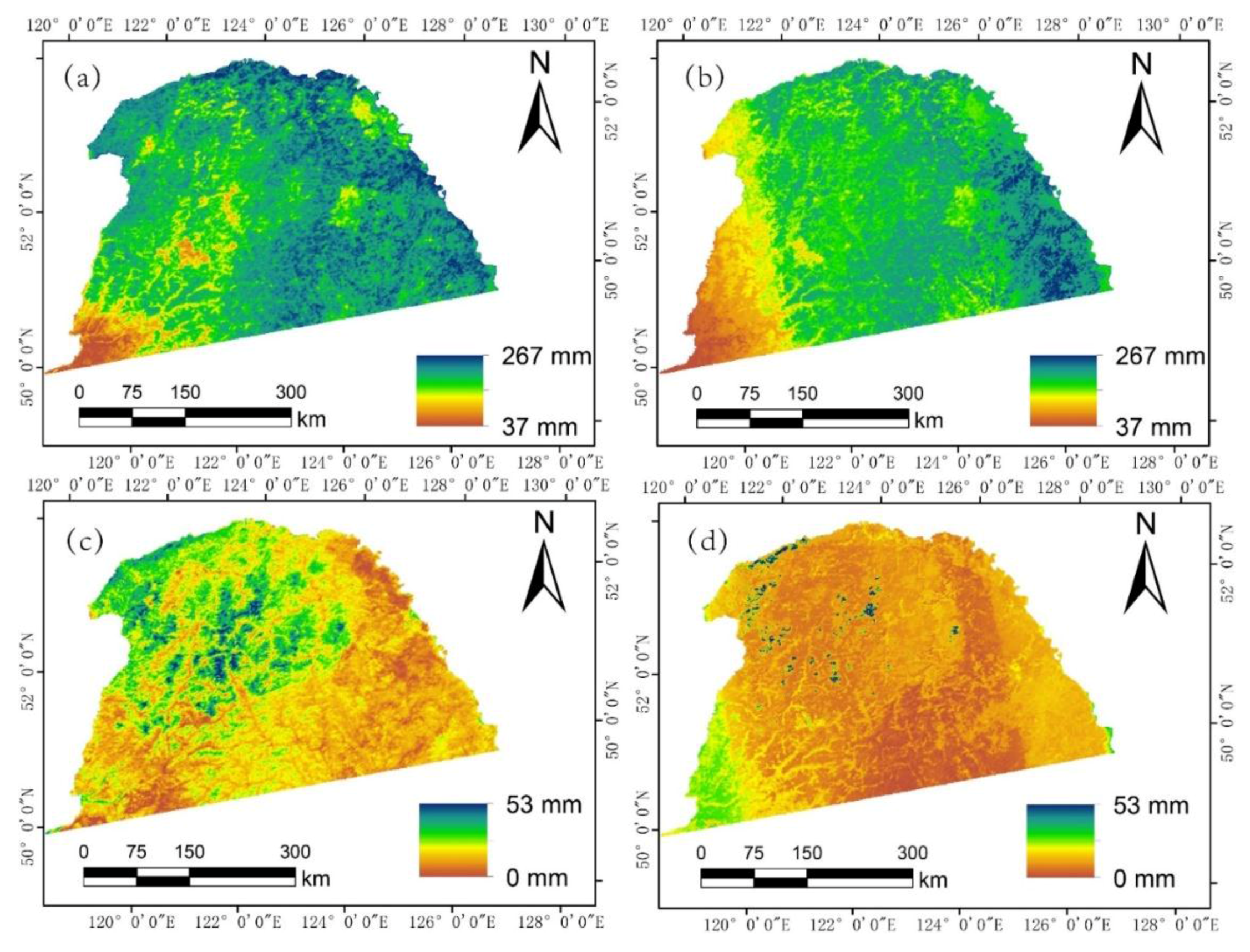
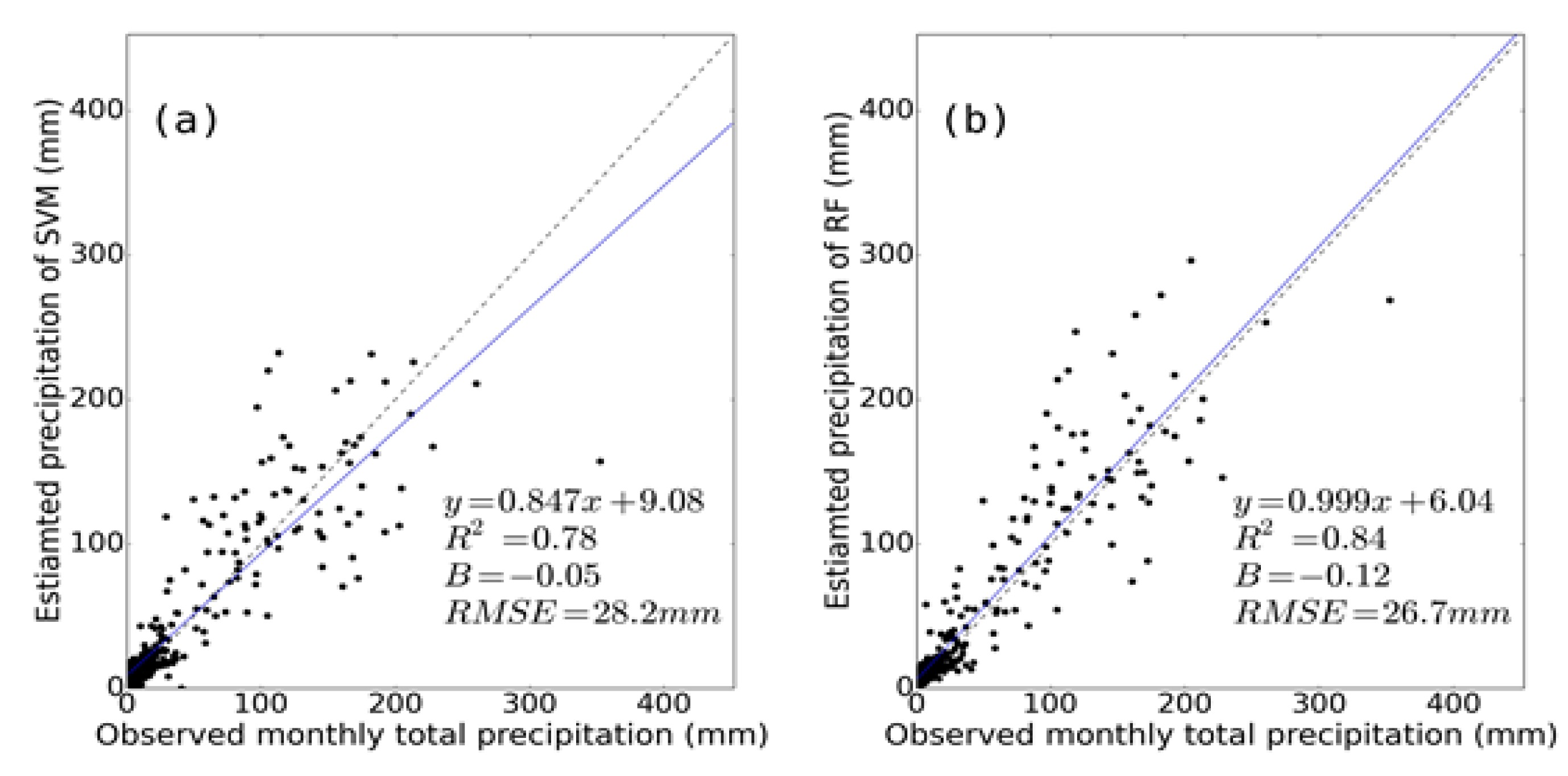

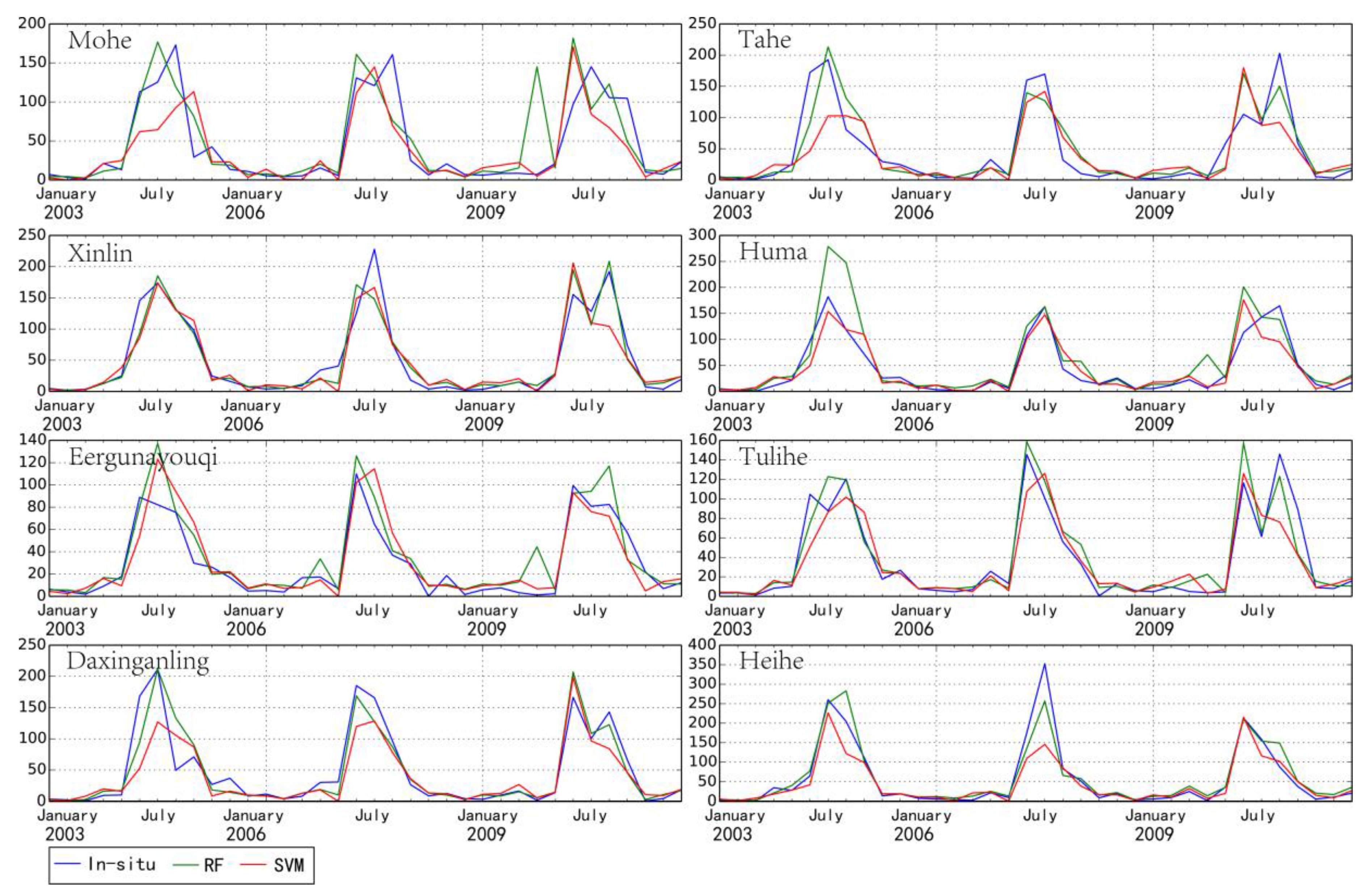
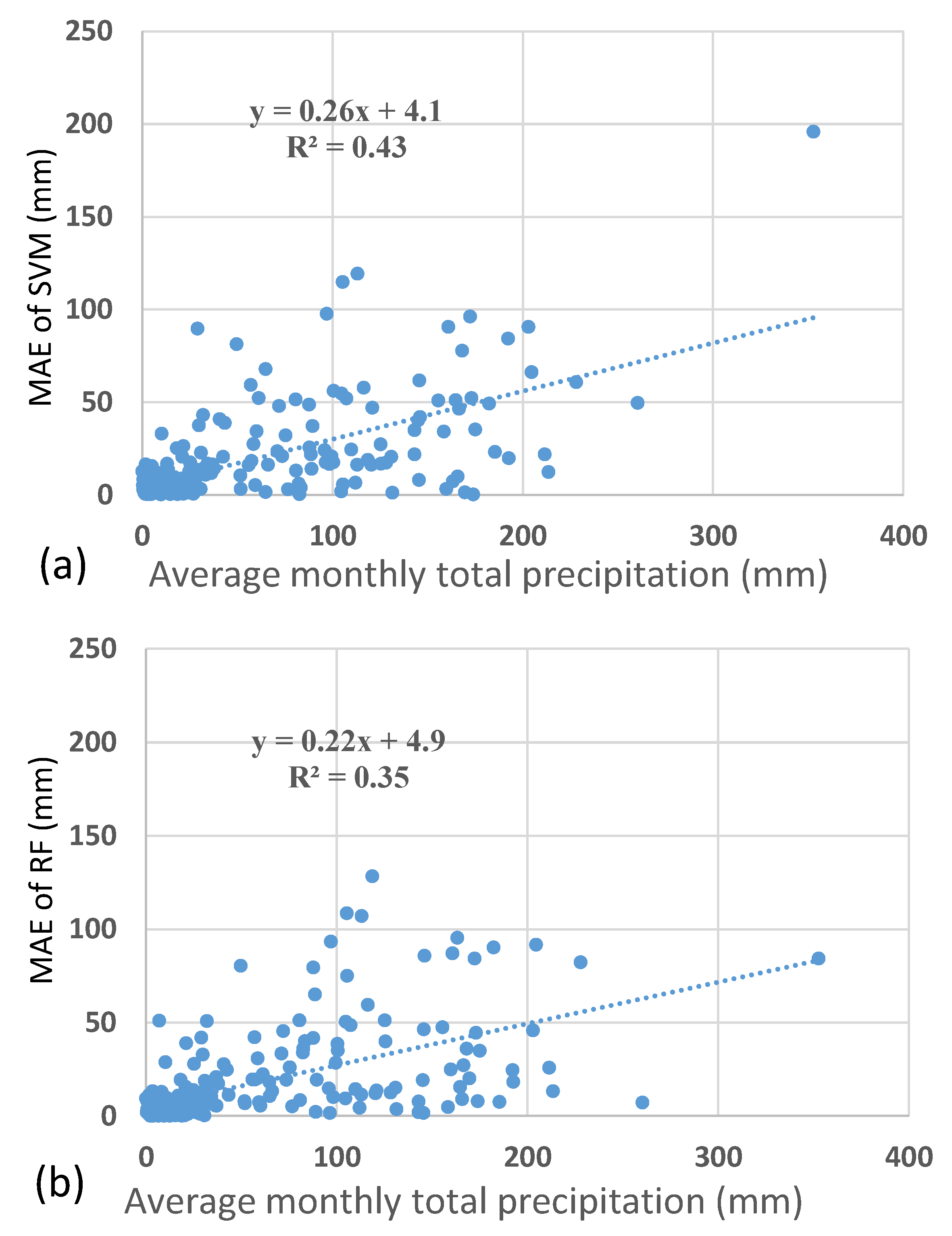
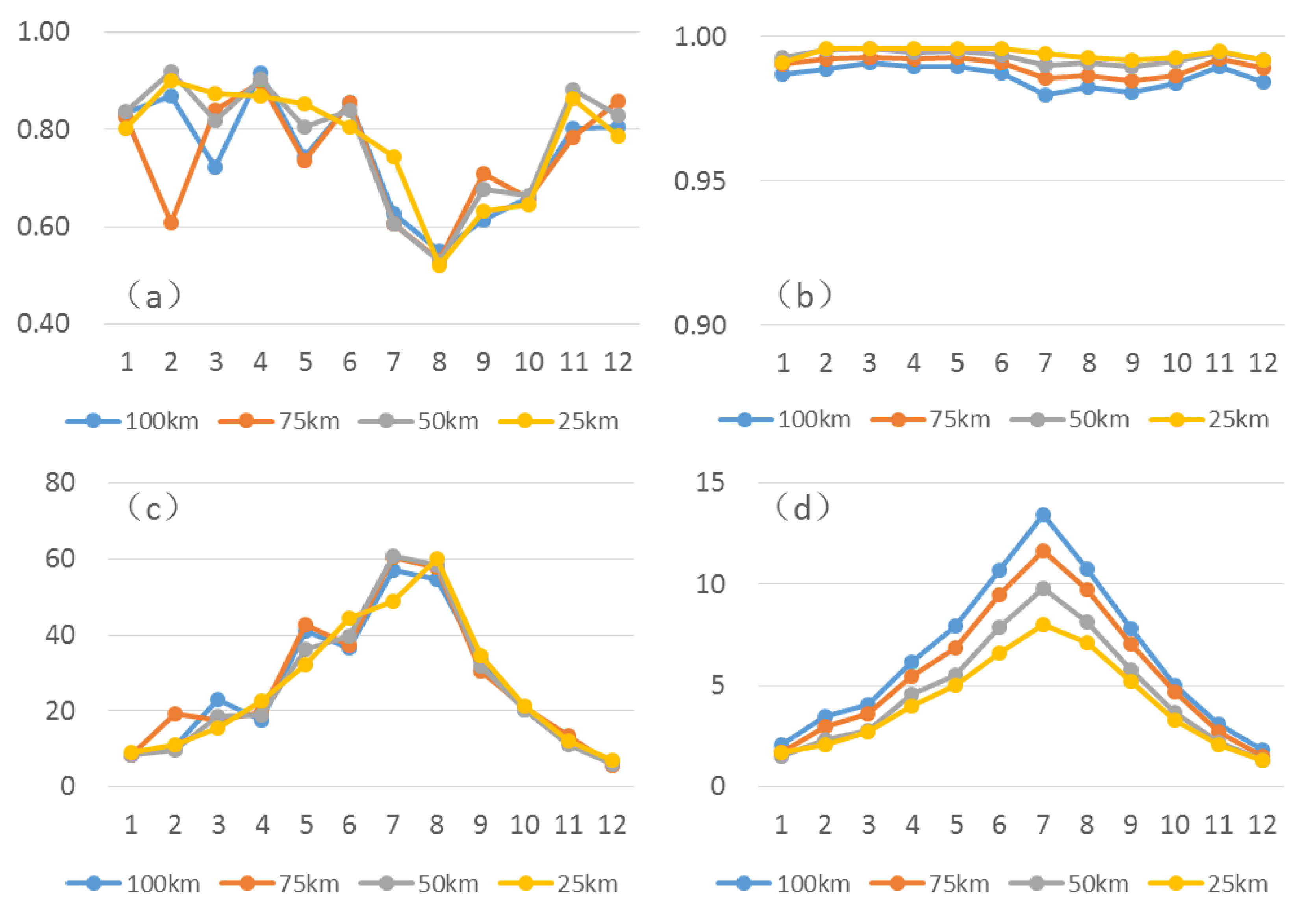


| Algorithm | Parameter Type | Parameters |
|---|---|---|
| Support Vectors Machine | Kernel | rbf |
| Cost(C) | 20, 40, 60,80,100, 150, 200, 220, 250, 280,300 | |
| gamma | 2−6, 2−5, 2−4, 2−3, 2−2, 2−1, 1, 21, 22, 23, 24, 25, 26 | |
| Random Forests | n_estimators | 20, 40, 60, 80, 100, 120, 140, 160, 180, 200 |
| Month | SVM | RF | ||||
|---|---|---|---|---|---|---|
| R2 | MAE (mm) | RMSE (mm) | R2 | MAE (mm) | RMSE (mm) | |
| January | 0.803 | 4.2 | 8.9 | 0.991 | 0.7 | 1.7 |
| February | 0.901 | 5.1 | 11.0 | 0.996 | 1.0 | 2.1 |
| March | 0.875 | 7.5 | 15.5 | 0.996 | 1.4 | 2.7 |
| April | 0.870 | 11.8 | 22.6 | 0.996 | 2.2 | 4.0 |
| May | 0.853 | 17.8 | 32.1 | 0.996 | 2.9 | 5.0 |
| June | 0.806 | 25.7 | 44.3 | 0.996 | 3.9 | 6.6 |
| July | 0.743 | 30.0 | 49.0 | 0.994 | 5.0 | 8.0 |
| August | 0.522 | 36.5 | 60.0 | 0.993 | 4.2 | 7.1 |
| September | 0.633 | 19.9 | 34.5 | 0.992 | 3.1 | 5.2 |
| October | 0.647 | 9.9 | 21.4 | 0.993 | 1.8 | 3.3 |
| November | 0.863 | 6.2 | 12.1 | 0.995 | 1.1 | 2.1 |
| December | 0.786 | 3.4 | 7.0 | 0.992 | 0.6 | 1.3 |
| Average | 0.775 | 14.8 | 26.5 | 0.994 | 2.3 | 4.1 |
| Station | R2 | RMSE (mm) | B | |||
|---|---|---|---|---|---|---|
| SVM | RF | SVM | RF | SVM | RF | |
| Mohe | 0.66 | 0.72 | 32.53 | 31.30 | −0.02 | −0.09 |
| Tahe | 0.71 | 0.76 | 34.59 | 31.87 | −0.11 | −0.12 |
| Xinlin | 0.85 | 0.89 | 24.96 | 21.60 | 0.06 | 0.01 |
| Huma | 0.83 | 0.88 | 28.52 | 38.38 | −0.17 | −0.28 |
| Eergunayouqi | 0.88 | 0.92 | 16.54 | 13.67 | −0.19 | −0.18 |
| Tulihe | 0.86 | 0.93 | 21.80 | 21.13 | −0.16 | −0.18 |
| Daxinganling | 0.86 | 0.91 | 23.63 | 19.29 | 0.01 | −0.03 |
| Heihe | 0.86 | 0.90 | 37.20 | 27.23 | 0.16 | −0.07 |
| Station | R2 | RMSE (mm) | B | |||
|---|---|---|---|---|---|---|
| SVM | RF | SVM | RF | SVM | RF | |
| Mohe | 0.66 | 0.72 | 32.53 | 31.30 | −0.02 | −0.09 |
| Tahe | 0.71 | 0.76 | 34.59 | 31.87 | −0.11 | −0.12 |
| Xinlin | 0.85 | 0.89 | 24.96 | 21.60 | 0.06 | 0.01 |
| Huma | 0.83 | 0.88 | 28.52 | 38.38 | −0.17 | −0.28 |
| Eergunayouqi | 0.88 | 0.92 | 16.54 | 13.67 | −0.19 | −0.18 |
| Tulihe | 0.86 | 0.93 | 21.80 | 21.13 | −0.16 | −0.18 |
| Daxinganling | 0.86 | 0.91 | 23.63 | 19.29 | 0.01 | −0.03 |
| Heihe | 0.86 | 0.90 | 37.20 | 27.23 | 0.16 | −0.07 |
© 2017 by the authors. Licensee MDPI, Basel, Switzerland. This article is an open access article distributed under the terms and conditions of the Creative Commons Attribution (CC BY) license (http://creativecommons.org/licenses/by/4.0/).
Share and Cite
Jing, W.; Zhang, P.; Jiang, H.; Zhao, X. Reconstructing Satellite-Based Monthly Precipitation over Northeast China Using Machine Learning Algorithms. Remote Sens. 2017, 9, 781. https://doi.org/10.3390/rs9080781
Jing W, Zhang P, Jiang H, Zhao X. Reconstructing Satellite-Based Monthly Precipitation over Northeast China Using Machine Learning Algorithms. Remote Sensing. 2017; 9(8):781. https://doi.org/10.3390/rs9080781
Chicago/Turabian StyleJing, Wenlong, Pengyan Zhang, Hao Jiang, and Xiaodan Zhao. 2017. "Reconstructing Satellite-Based Monthly Precipitation over Northeast China Using Machine Learning Algorithms" Remote Sensing 9, no. 8: 781. https://doi.org/10.3390/rs9080781






